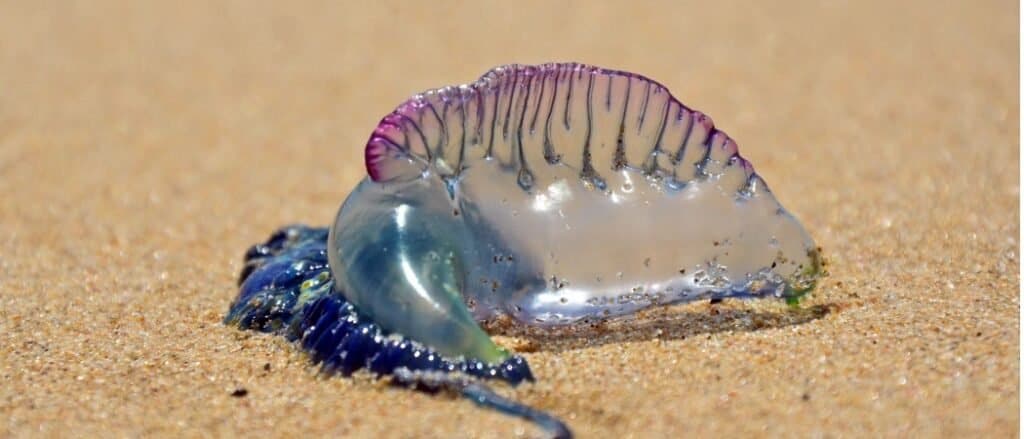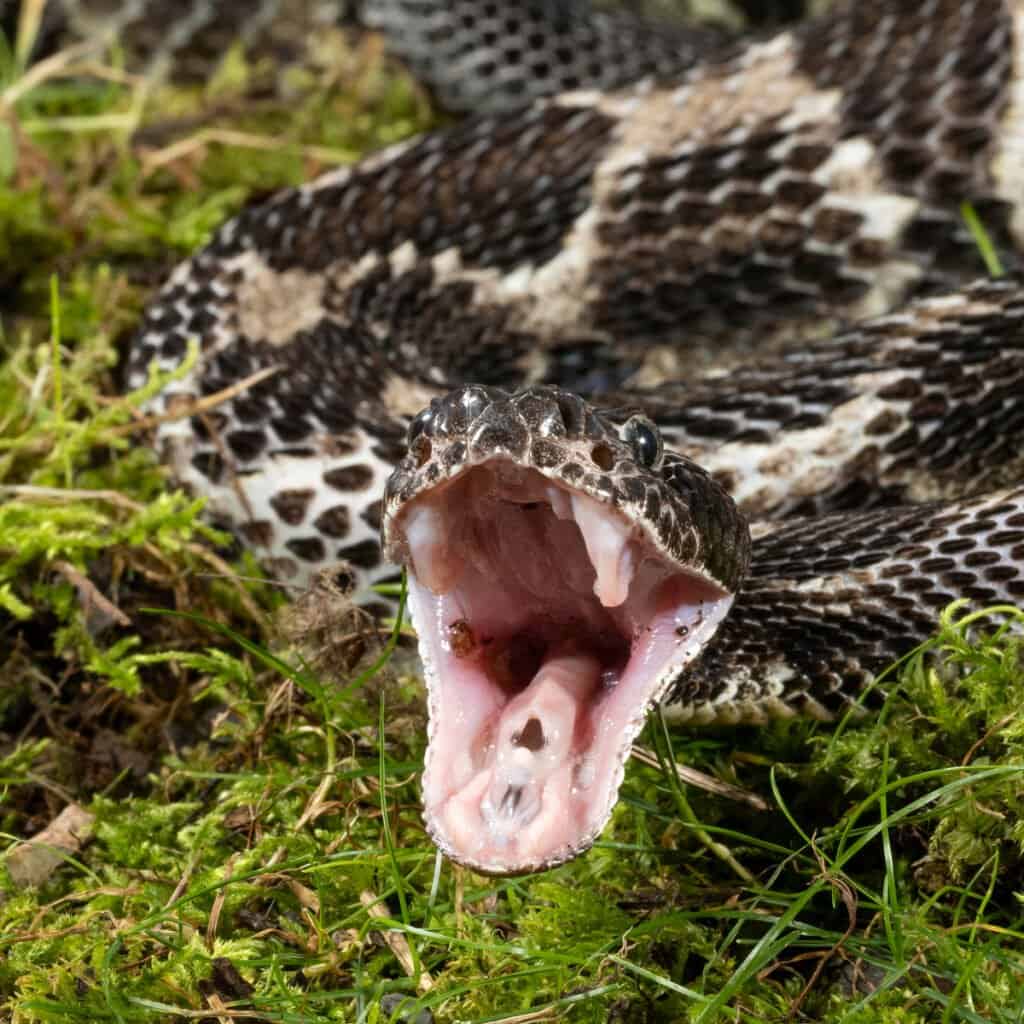In general, Delaware is not known for any outrageously dangerous animals. Their state animal for example is a chicken, a blue hen to be exact. The University of Delaware teams proudly exclaim to be the “Fightin’ Blue Hens”, okay maybe not that intimidating, but tougher than the state insect, the ladybug. That would be a stretch to have your football team called the “Fightin’ Ladybugs”. The state marine animal is the horseshoe crab and the state mammal is the gray fox. Gray foxes have long bushy tails and can get to be 3 feet long, including the tail, and they usually weigh 8 – 14lbs. So, are there any dangerous animals in Delaware? Let’s take a look at some of the animals in the state and discover the deadliest animals in Delaware!
Are there sharks off the coast of Delaware?

Sand
tiger
sharks are one of the most common sharks around Delaware
©iStock.com/mirror-images
The Delaware coast includes the Delaware Bay and the Atlantic Ocean. There are a few sandy beaches that line the coastline, so what kind of dangers should beach goers be aware of? There are sharks in both the bay and along the Atlantic, but the most common are sand bar sharks, sand tiger sharks and dogfish sharks.
Two notable shark stories out of Delaware are a sighting of a 900lb white shark that made its way into the bay. The research group called OCEARH has been tagging and tracking marine animals up and down the coast. The tags send a “ping” to the researchers when the sharks surface, indicating their location. This shark (whom they’ve named Freya) pinged just off Slaughter Beach in the Delaware Bay on June 17, 2021. The next day she was located back in the Atlantic heading north and three days later was pinged off the coast of Rhode Island.
In general there are very few shark attacks on humans with only 33 unprovoked shark bites in the US in 2020. One of those shark bites did occur off the coast of Delaware. In Cape Henlopen State Park a 16-year-old teen was bitten on his arm by a shark. He was taken to the hospital where he did need 23 stitches to close the wound. Based on the look of the bite biologists believe it was a young sand bar shark. There have only been four shark attacks off the coast of Delaware since 1940 and none of them have been fatal.
What other dangerous animals are off the coast of Delaware?

Man of War jellyfish are one of the most dangerous animals around the Delaware coast
©KarenHBlack/Shutterstock.com
The Portuguese man o’ war is a crazy looking creature, I say creature because it is hard to know if it is a fish, a jellyfish or what? It is actually a siphonophore which is a colony of polyps that live together as one system. The clear “float” looks like a clear plastic bag and floats on top of the water, then there is a blue colored “body” and connected to that are long skinny tentacles that hang below. The float and body are about 6 inches in length, but the tentacles can be 100 feet…yes, that’s right 100 feet long! These tentacles are what are dangerous to animals and humans alike.
The sting from a Portuguese man o’ war is very painful due to the venom and can leave a large welt on your skin. They often swim in large groups so can be easy to spot. If you find one on the beach just stay away from it. Even if it looks dead, the venom can stay active for a period of time after their death. In 2015 there were several reports of these creatures washing up on shore and beach officials putting out notices to the public. The Department of Natural Resources and Environmental Control said that it had been 15-years since they had had any sightings so people needed to be educated about their dangers.
Although fatalities related to the Portugese man o’ war are extremely rare there was a case of a person in Florida that died from a sting in 1987. Another incident included a group of beachgoers in Hollywood, Florida back in 2018. In just one day, the lifeguards reported treating 204 people with stings. Before enjoying the beach watch for the purple flag sea animal warnings and keep your eye out for these creatures in the water and on the land.
What land animals are dangerous in Delaware?

The timber
rattlesnake
is one of two venomous snakes in Delaware
©Joe McDonald/Shutterstock.com
Many states list the dangers of hiking or camping in bear country, but that is of no concern in Delaware. There are not any populations of black bears in Delaware. There have not been any confirmed cougar sightings in Delaware either. Although there have been bobcat sightings, they are very rare. So what land animals are dangerous in Delaware?
- Timber rattlesnake: The state of Delaware has two venomous snakes including the timber rattler which is sometimes called the banded rattler due to the dark bands around its body. They are large snakes that can be 3 – 4 feet long! At the tip of their tail is their rattle which they will use to scare off predators and humans. Unfortunately, there are quite a few snake bites in the US, but only a few are fatal with an average of 5 per year.
- Copperhead: One of those reported snake bites was from a copperhead snake in Delaware in 2019. The man was in his backyard, not hiking in the park, when he was bitten and then taken to the hospital. He was later released, but a scary event for sure. Copperheads blend in with their surroundings so can be hard to see.
- White-tailed deer: Deer don’t seem that imposing, but the issue with deer is collisions with cars and other vehicles, especially during the fall months. According to the Delaware Office of Highway Safety (OHS) there were 1,004 crashes with deer between September 2020 and February 2021, but of those only 3.7% reported human injuries. They warn people to be extra aware during the fall months and during the sunset hours when the deer are on the move. Also, if you see one deer, be on the lookout for more since they often travel together.
- Deer ticks: If you have a lot of deer you probably have a lot of deer ticks, which can lead to an overlooked danger – tick borne diseases. The deer ticks are known to carry Lyme disease which is the most common tick born infection in Delaware. There were 346 confirmed cases of this disease in 2020, just in Delaware. Although most cases of Lyme disease are resolved shortly after the tick bite heals, there can be long term affects like muscle aches, flu-like symptoms and fatigue. Researchers continue to study the disease and how to help those that continue to suffer from it. The best way to avoid being bitten by a tick is to wear appropriate clothing like long sleeves and tuck your pants into your socks. You can also check for ticks when coming in and examine yourself for any signs of a tick bite. Taking these precautions can make help keep you safe so you can enjoy the great outdoors in Delaware.
Up Next
- Discover The Deadliest Animals In Louisiana
- The Top 10 Deadliest Animals In America
- The 9 Most Dangerous Animals On Earth To Humans
The photo featured at the top of this post is © Valeri Potapova/Shutterstock.com
Thank you for reading! Have some feedback for us? Contact the AZ Animals editorial team.







